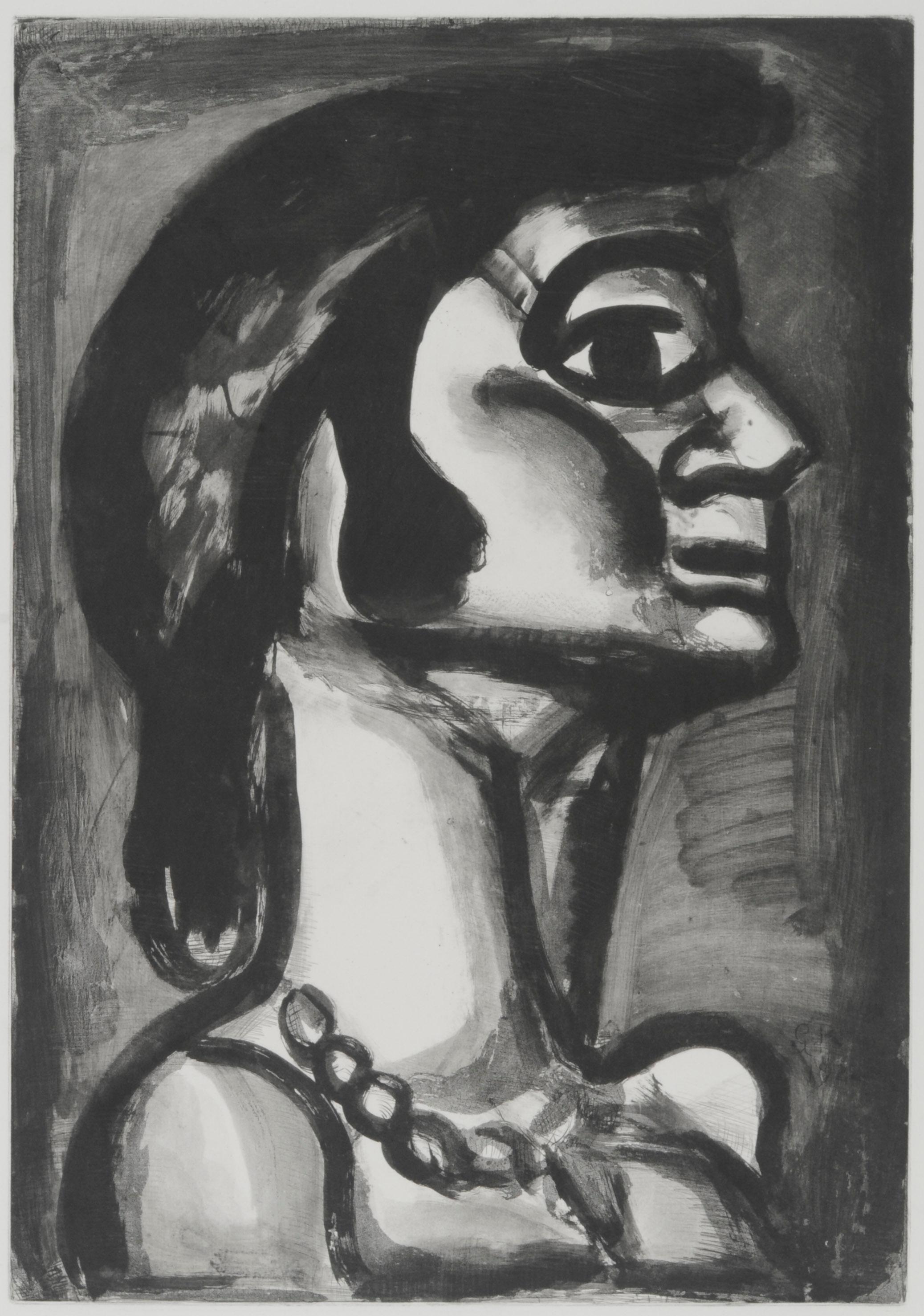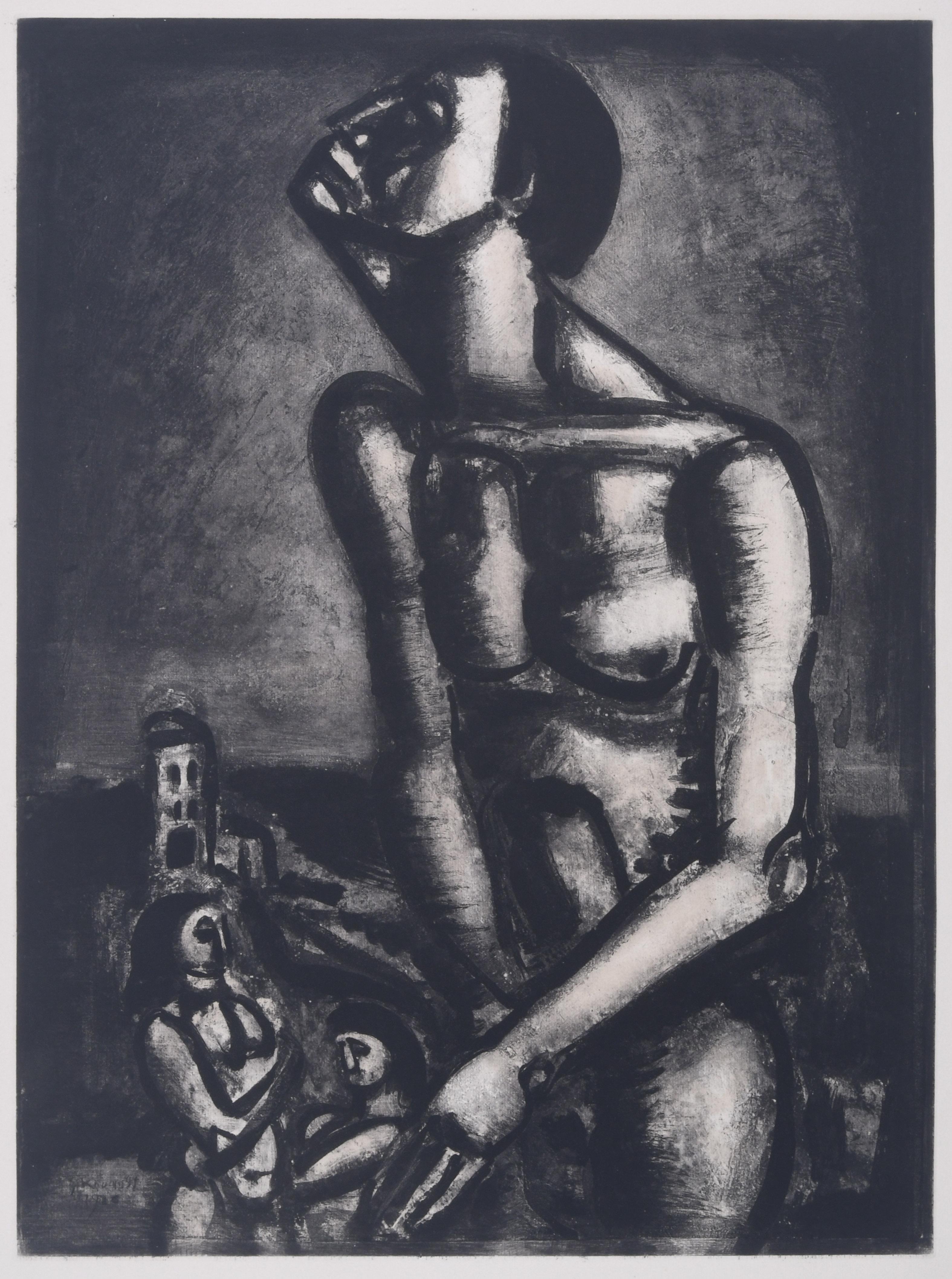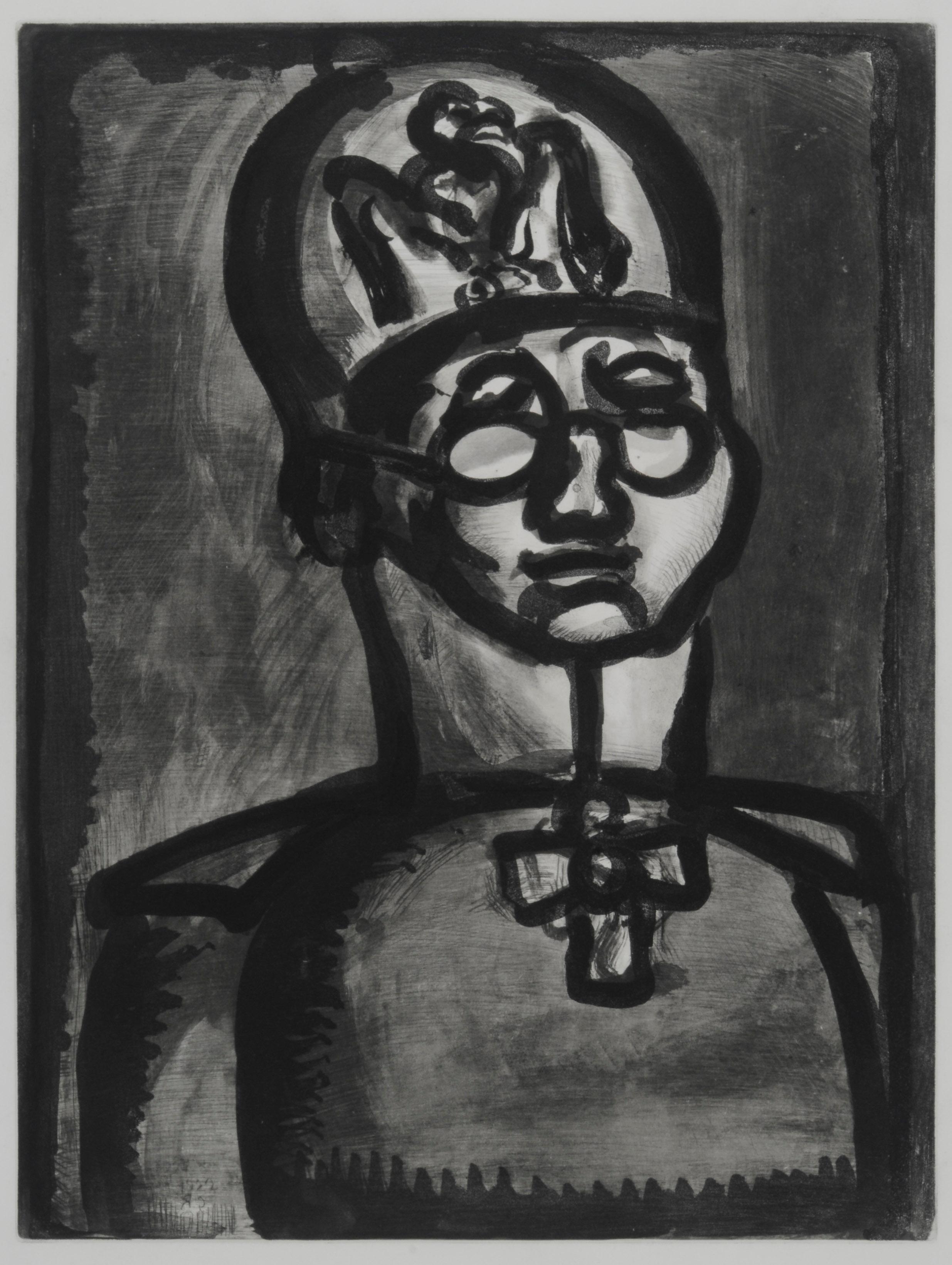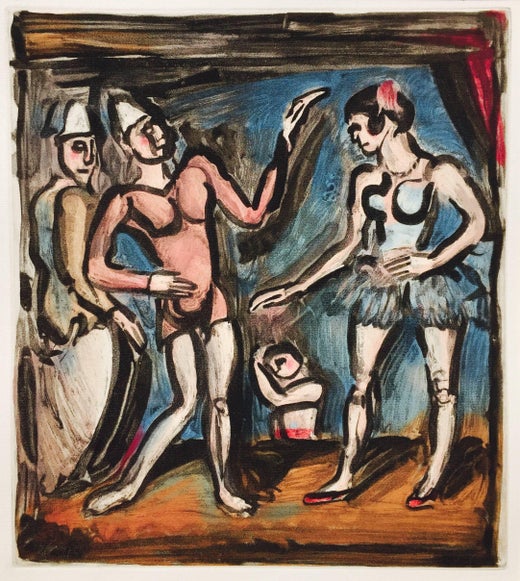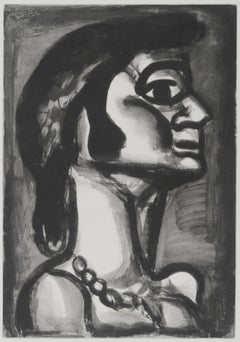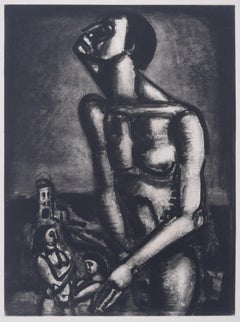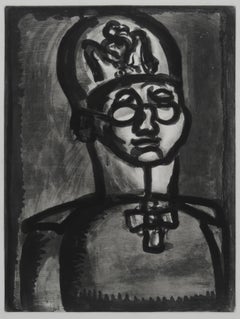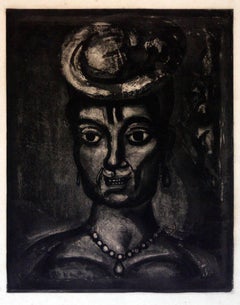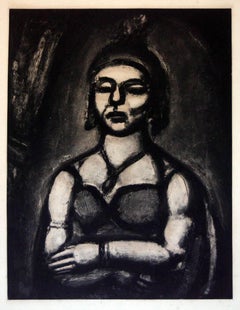Items Similar to En bouche qui fut fraîche, goût de fiel (In the mouth that was once fresh, ...
Want more images or videos?
Request additional images or videos from the seller
1 of 8
Georges RouaultEn bouche qui fut fraîche, goût de fiel (In the mouth that was once fresh, ...1922
1922
$1,700
£1,290.08
€1,477.25
CA$2,415.82
A$2,629.32
CHF 1,380.37
MX$31,766.08
NOK 17,325.19
SEK 16,335.61
DKK 11,027.51
About the Item
En bouche qui fut fraîche, goût de fiel (In the mouth that was once fresh, the taste of bitterness)
Aquatint, drypoint, roulette and burnishing over heliogravure, 1922
Unsigned as issued
From: Miserere (Have Mercy), 58 plates
Plate 15
Aquatint, drypoint, roulette and burnishing over heliogravure
1922-1927
Edition: 425 on Arches vellum with the Ambrose Vollard watermark
25 Hors commerce portfolios
All published impression are unsigned, as issued
Signed and numbered only on the colophon
Published by Societe d’Editions l’Etoile Filante, Paris, 1948
Printer: Jacquemin, Paris, 1922-1927
Condition: Excellent
Image/Plate size: 19 7/8 x 13 7/8 inches
Reference: Chapon & Rouault 68 d/d
Flora and Kang cite Lamentations 3:18-23 as a possible verbal equivalent: "my soul is bereft of peace; I have forgotten what happiness is; so I say, ‘Gone is my glory, and all that I had hoped for from the Lord.’ The thought of my affliction and my homelessness is wormwood and gall! My soul continually thinks of it and is bowed down within me."
Rouault’s Miserere (Mercy) series, first titled Miserere et Guerre (Mercy and War), was commissioned in 1916 by art dealer Ambroise Vollard (1865–1939). Originally planned as a two-volume book comprised of 50 prints each, Miserere was only partially realized — with 58 prints published in 1948. The series illustrates man’s cruelty to man, relates human suffering to the passion of Christ, and speaks to the redemption and salvation that can be achieved through that experience.” Haggerty Museum of Art
‘Rouault began his Miserere series during the somber days of World War I and had finished it by 1927. He first drew the images in India ink and later reproduced them as engravings, reworking the plates over the years—scraping deeper with a file or sanding with emery paper.
He later wrote of this time: “When I was about thirty, I felt a stroke of lightning, or of grace, depending on one’s perspective. The face of the world changed for me. I saw everything that I had seen before, but in a different form and with a different harmony.”
“Rouault was born into a poor family in the Belleville neighborhood of Paris during the Franco-Prussian War at the end of the 19th century, and he lived and worked in the city through both the first and second world wars. Apprenticed at age 14 to a stained-glass restorer working on Saint-Severin Church in Paris, Rouault attended the Ecole des Beaux-Arts alongside Matisse. His mentor there was the Symbolist Gustave Moreau, and the influence of this early master of intuitive self-examination and personal mythmaking never left him. Encouraged by Moreau to look inward at the same time that his day-to-day life was saturated with the suffering of poverty and war, Rouault drew early and often on the subjects he had learned about while working on the stained glass in Parisian cathedrals, especially the Stations of the Cross.” Westmont College
“The series (Miserere) is concerned with three types of humanity: the bourgeoisie, who are depicted as vicious and deluded; the poor and outcast, who are seen as ennobled by suffering; and Jesus Christ, who is the archetype and the analogue of both the artist and his beloved outsiders.”
Westmont College
“The artist has contrived a method that allows black-and-white prints to glow with the inner light of stained glass and ripple with the atmospheric brushstrokes and washes of painting. The style is deliberately simple, but the rigorous logic of its conception and the infinitely patient authority of its execution result in something deep and powerful.” Westmont College
- Creator:Georges Rouault (1871-1958, French)
- Creation Year:1922
- Dimensions:Height: 19.88 in (50.5 cm)Width: 13.88 in (35.26 cm)
- Medium:
- Movement & Style:
- Period:
- Condition:
- Gallery Location:Fairlawn, OH
- Reference Number:Seller: FA120461stDibs: LU14015238402
Georges Rouault
Executed in 1937, Carlotta belongs to a group of portraits of members of society. Unlike Picasso and Toulouse-Lautrec, who portrayed these individuals with pathos, Rouault’s approach was unapologetic and raw. In the present work several layers of pigment can be discerned; the build-up of translucent and opaque layers of paint creates a three-dimensionality that characterizes the artist’s strongest work. Furthermore, the work is highlighted by the deep swaths of black delineating the subject, representing a signature element of Rouault’s portraiture of this period.
About the Seller
5.0
Recognized Seller
These prestigious sellers are industry leaders and represent the highest echelon for item quality and design.
Platinum Seller
Premium sellers with a 4.7+ rating and 24-hour response times
Established in 1978
1stDibs seller since 2013
815 sales on 1stDibs
Typical response time: <1 hour
Associations
International Fine Print Dealers Association
- ShippingRetrieving quote...Shipping from: Fairlawn, OH
- Return Policy
Authenticity Guarantee
In the unlikely event there’s an issue with an item’s authenticity, contact us within 1 year for a full refund. DetailsMoney-Back Guarantee
If your item is not as described, is damaged in transit, or does not arrive, contact us within 7 days for a full refund. Details24-Hour Cancellation
You have a 24-hour grace period in which to reconsider your purchase, with no questions asked.Vetted Professional Sellers
Our world-class sellers must adhere to strict standards for service and quality, maintaining the integrity of our listings.Price-Match Guarantee
If you find that a seller listed the same item for a lower price elsewhere, we’ll match it.Trusted Global Delivery
Our best-in-class carrier network provides specialized shipping options worldwide, including custom delivery.More From This Seller
View AllEn bouche qui fut fraîche, goût de fiel (In the mouth that was once fresh, ...
By Georges Rouault
Located in Fairlawn, OH
En bouche qui fut fraîche, goût de fiel (In the mouth that was once fresh, the taste of bitterness)
Aquatint, drypoint, roulette and burnishing over heliogravure, 1922
Unsigned as ...
Category
1920s French School Figurative Prints
Materials
Aquatint
En bouche qui fut fraîche, goût de fiel (In the mouth that was once fresh, ...
By Georges Rouault
Located in Fairlawn, OH
En bouche qui fut fraîche, goût de fiel (In the mouth that was once fresh, the taste of bitterness)
Aquatint, drypoint, roulette and burnishing over heliogravure, 1922
Unsigned as ...
Category
1920s French School Figurative Prints
Materials
Aquatint
Ne sommes-nous pas forçats? (Are we not Slaves?)
By Georges Rouault
Located in Fairlawn, OH
Ne sommes-nous pas forçats? (Are we not Slaves?)
Aquatint and heliogravure on Arches laid paper watermarked "Ambroise Vollard"
Signed and dated in the plate lower left (see photo)
P...
Category
1920s French School Figurative Prints
Materials
Aquatint
Loin du sourire de Reims (Far from the Smile of Rheims)
By Georges Rouault
Located in Fairlawn, OH
Loin du sourire de Reims (Far from the Smile of Rheims)
Aquatint, drypoint, roulette and burnishing over heliogravure, 1922
Signed with the initials in the plate and dated (see photo...
Category
1920s French School Figurative Prints
Materials
Aquatint
Fille dite de joie (They Call Her Daughter of Joy)
By Georges Rouault
Located in Fairlawn, OH
Fille dite de joie (They Call Her Daughter of Joy)
Aquatint, drypoint, roulette and burnishing over heliogravure, 1922-1927
Unsigned (as issued)
From: Miserere (Have Mercy), 58 plate...
Category
1920s French School Figurative Prints
Materials
Aquatint
Vierge aux sept glaives (The Virgin pierced by seven swords) (Sorrowful Mother)
By Georges Rouault
Located in Fairlawn, OH
Vierge aux sept glaives (The Virgin pierced by seven swords) (Sorrowful Mother)
Aquatint, drypoint, roulette and burnishing over heliogravure, 1926
Unsigned as issued
From: Miserere ...
Category
1920s French School Figurative Prints
Materials
Aquatint
You May Also Like
Cristal de Roche from Le Reincarnations du Pere Ubu, by Georges Rouault
By Georges Rouault
Located in Long Island City, NY
Cristal de Roche from Le Reincarnations du Pere Ubu
Georges Rouault, French (1871–1958)
Date: 1928
Aquatint on Arches, signed in the plate
Image Size: 12.5 x 8 inches
Size: 17.5 x 13...
Category
1920s Expressionist Figurative Prints
Materials
Aquatint
Femme Hideuse from The Reincarnations du Pere Ubu, by Georges Rouault
By Georges Rouault
Located in Long Island City, NY
Femme Hideuse from The Reincarnations du Pere Ubu
Georges Rouault, French (1871–1958)
Date: 1928
Etching with Aquatint, signed in the plate
Image Size: 12 x 8 inches
Size: 17 x 13 in...
Category
1920s Expressionist Figurative Prints
Materials
Etching, Aquatint
Femme Affranchie A' Quatorze Heures Chante Midi - Georges Rouault
By Georges Rouault
Located in Roma, IT
Signed on plate.
Edition of 450 prints, belonging to the suite “Miserere”, considered as the most important religious graphic work of XX century. The single prints, realized with a s...
Category
1940s Post-Impressionist Figurative Prints
Materials
Etching
Des Ongles Et Du Bec
By Georges Rouault
Located in Roma, IT
Edition of 450 prints, belonging to the suite “Miserere”, considered as the most important religious graphic work of XX century.
The single prints, realized with a sophisticated mixe...
Category
1940s Post-Impressionist Figurative Prints
Materials
Etching
$1,047 Sale Price
30% Off
(tariff free*) Le Moqueur, Divertissement, Éditions de la Revue Verve
By Georges Rouault
Located in Southampton, NY
Lithograph on vélin d'Arches paper, archivally mounted to a larger vélin d'Arches support sheet, as issued. Paper Size: 16 x 12.5 inches, overall; 11 x 8 inches, image. Inscription: ...
Category
1940s Modern Figurative Prints
Materials
Lithograph
$716 Sale Price
20% Off
Free Shipping
Femme Affranchie A' Quatorze Heures Chante Midi
By Georges Rouault
Located in Roma, IT
Signed on plate.
Edition of 450 prints, belonging to the suite “Miserere”, considered as the most important religious graphic work of XX century. The single prints, realized with a s...
Category
1940s Post-Impressionist Figurative Paintings
Materials
Etching
$2,346 Sale Price
30% Off
More Ways To Browse
Stations Of The Cross
Antique Cathedral Glass
Paul Klee Original
Peter Doig Canoe
Peter Max Toulouse Lautrec
Peter Max Toulouse
Phil Paradise
Picasso 1933
Picasso Acrobat
Picasso Boy
Picasso La Danse
Picasso Minotaur Print
Picasso Mother And Child
Picasso Pierrot
Picasso Prints Limited Editions
Picasso Stamped Signature
Picasso The Couple
Pietro Fontana Etching
